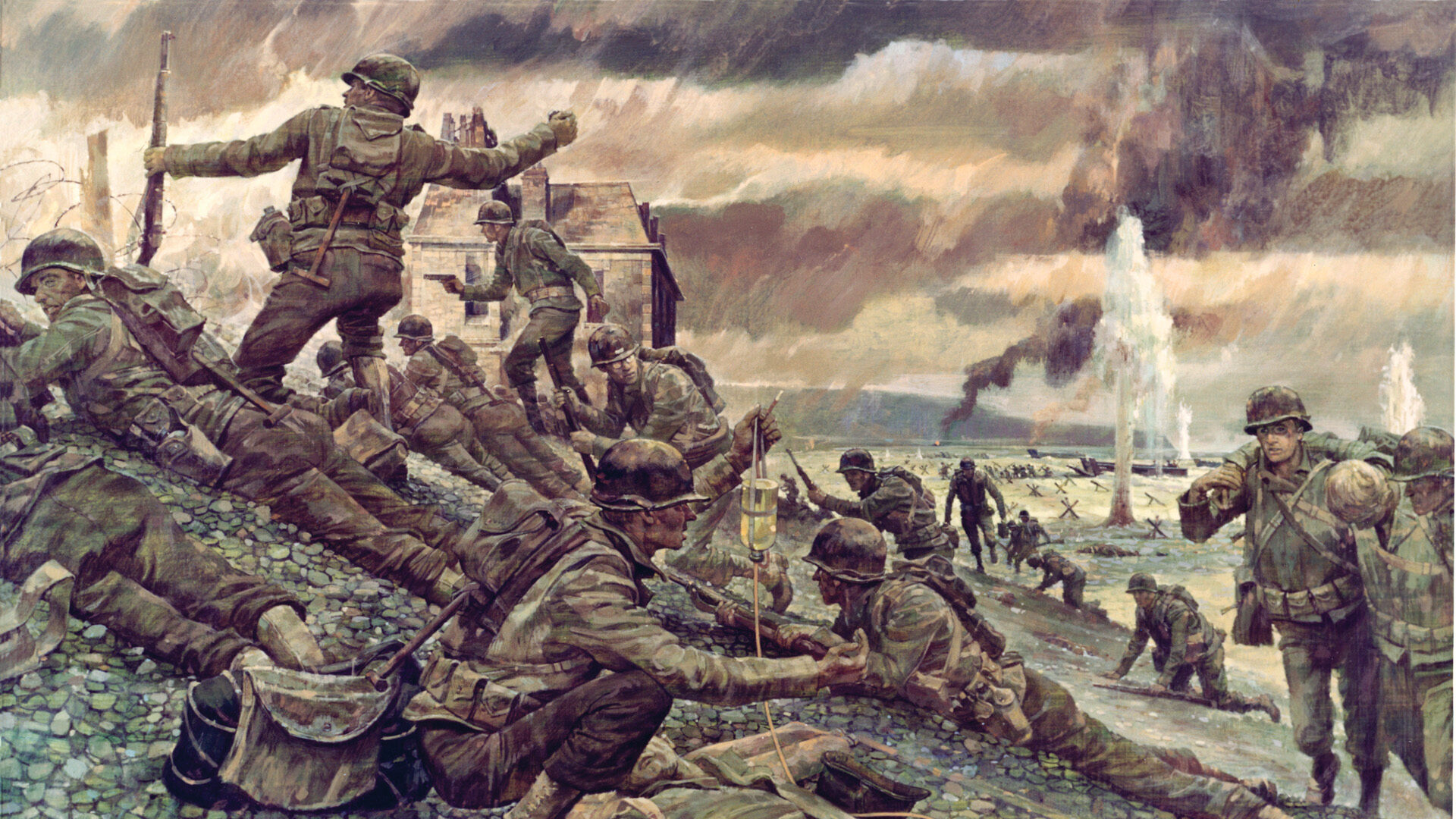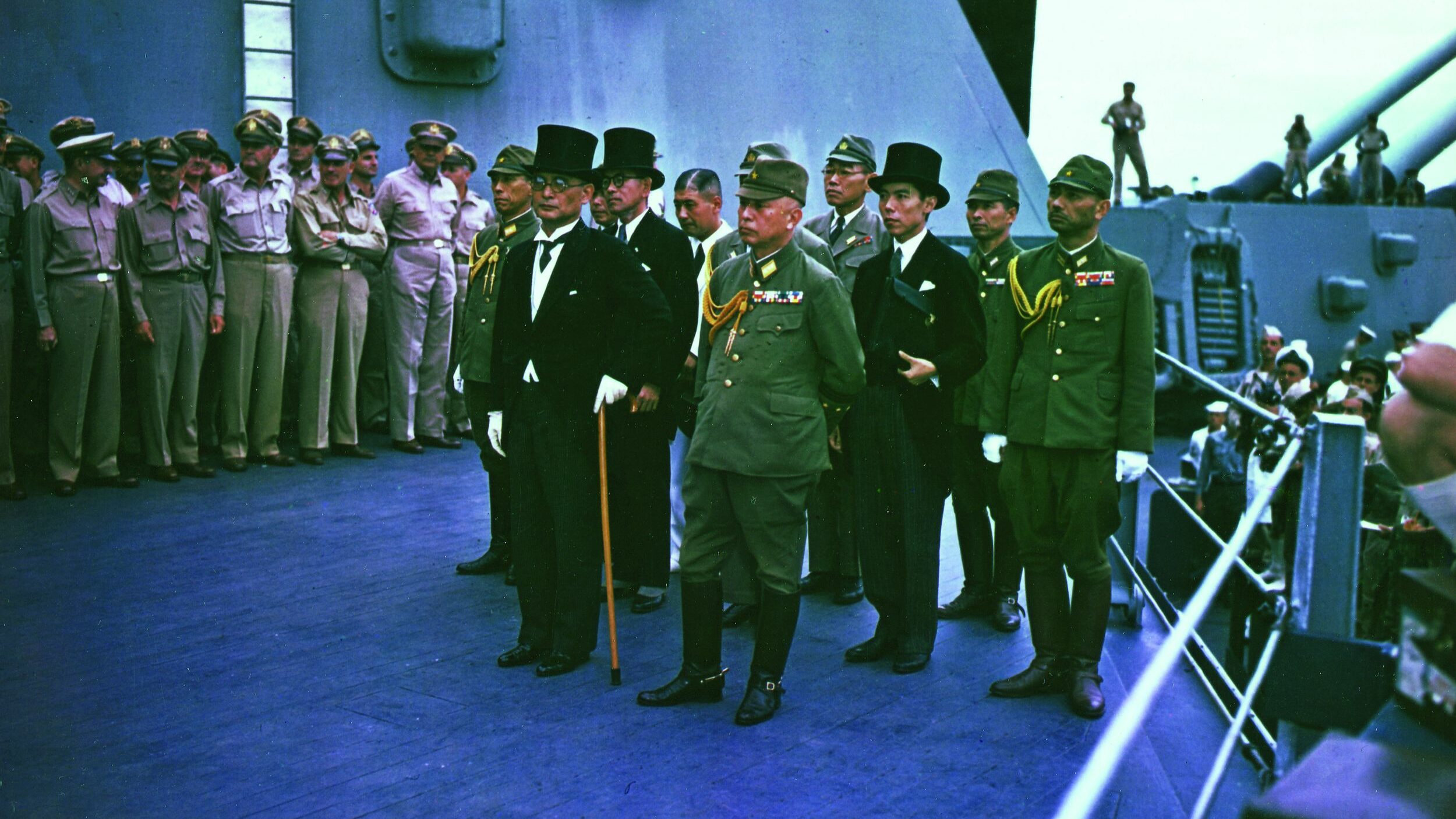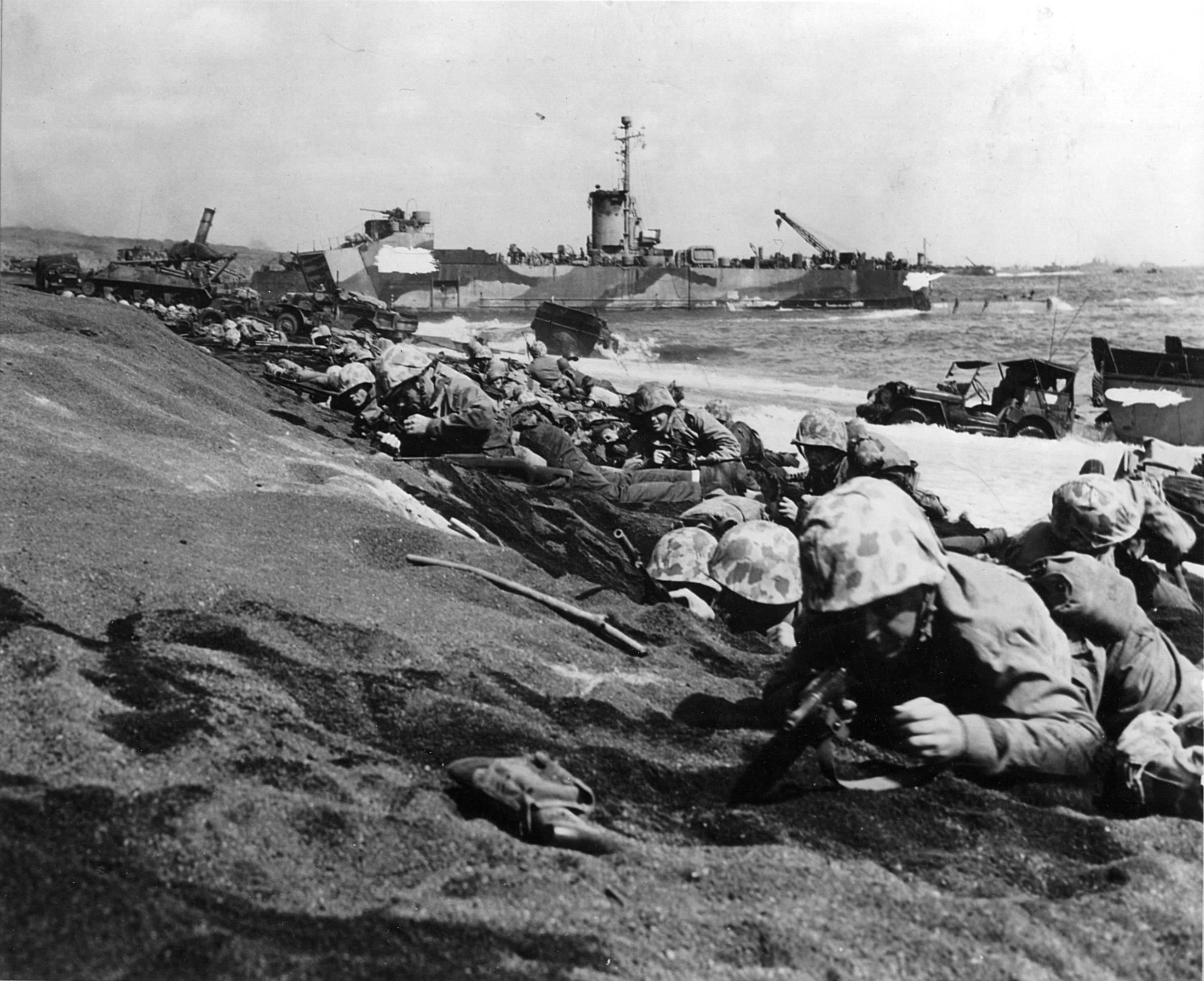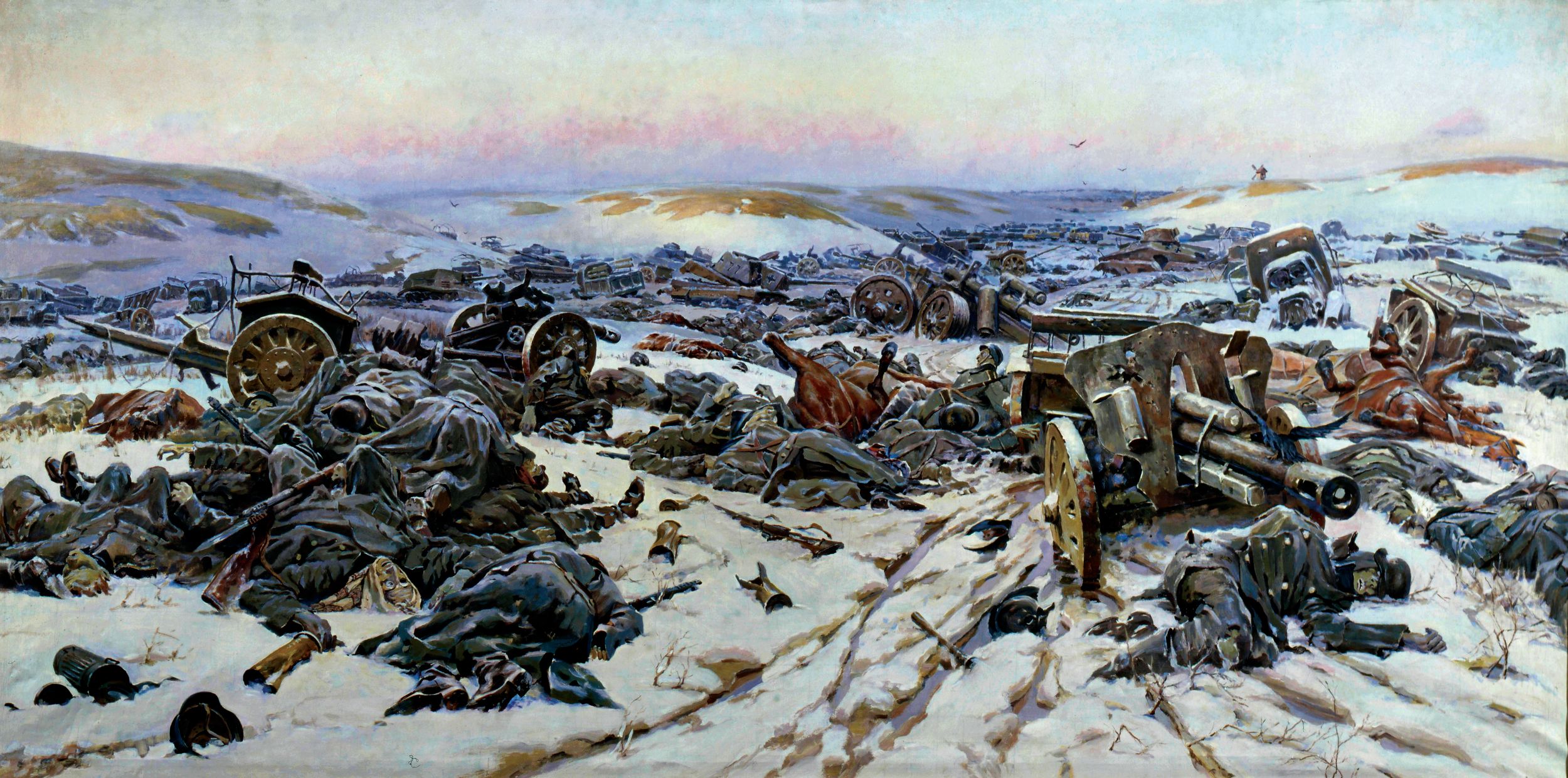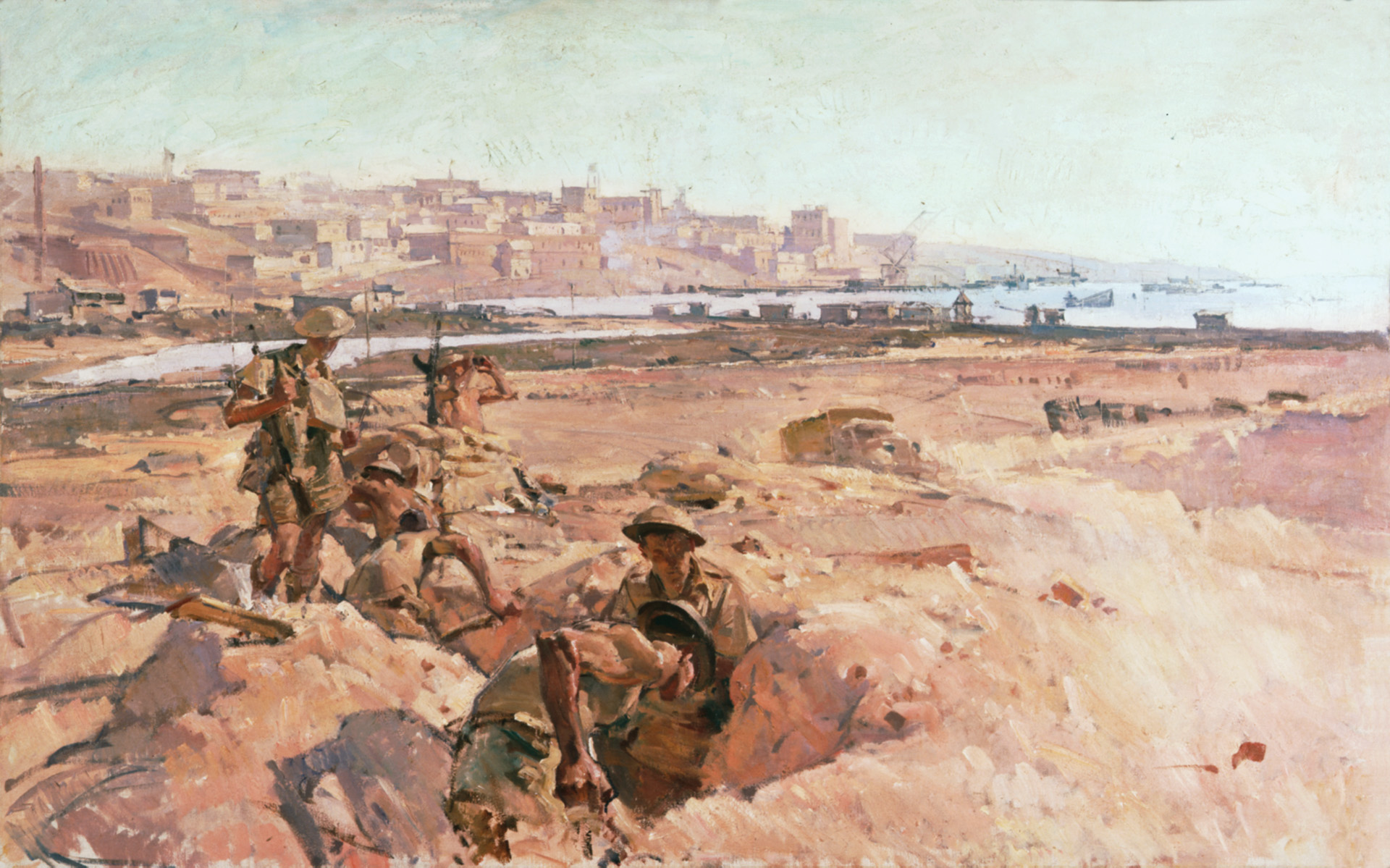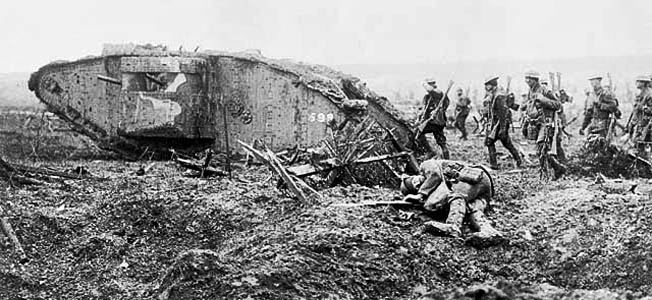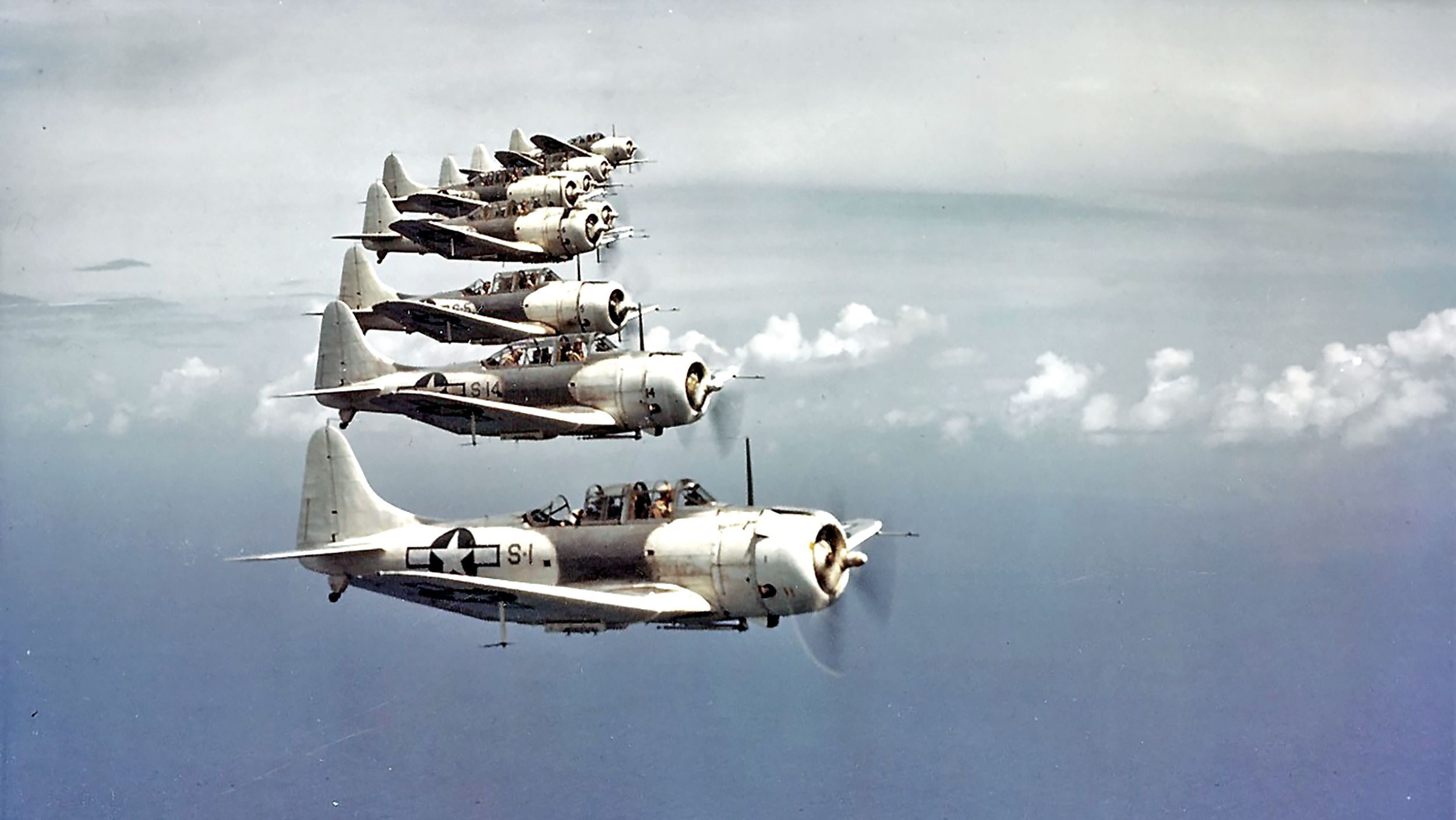By Kevin M. Hymel
Twelve Landing Craft Vehicle Personnel (LCVPs) carrying Captain William Callahan’s F Company and Captain Eccles Scott’s G Company—some 400 men—slapped the English Channel’s rough waves as they approached Omaha Beach’s Les Moulins Draw. Each LCVP carried 35 American infantrymen. As the craft formed up and headed to shore, most of the soldiers became seasick. Anyone popping his head over the side to vomit was shouted to duck back down. It was 6:30 am on June 6, 1944—D-Day—and the Western Allies were attacking France’s Normandy coast.
Some assault boats took direct hits as they approached the shore; others zigzagged to evade enemy fire, throwing their coordinated landing into chaos. The two companies were supposed to land abreast but instead were hopelessly intermixed. Four Sherman tanks had landed just minutes before, ready to support the infantry.
Rows of enemy obstacles covered the beach. To the right of the draw, 15 wooden breakwaters, built to prevent erosion, stretched like fingers from the beach into the water. Halfway up the beach, a shingle of smooth stones stood like a shallow hill. The beach ended at a seawall supporting a parallel-running road. A perpendicular road, the Les Moulins Draw, cut through the bluffs beyond and led away from the beach.
As the small craft neared the shore, their coxswains slowed and dropped their ramps. When the ramp failed to lower on one of Callahan’s LCVPs, the lieutenant in command yelled to his sergeant, “What do we do, sergeant?” The answer came back, “Go over the side, lieutenant!” As some men cupped their hands, the lieutenant stepped into the man-made stirrups and boosted himself over. Just then, the ramp dropped. The men struggled into the water and activated their inflatable life belts.
Private First Class John Robertson, in another of Callahan’s landing craft, leaned over the side to vomit. When his comrades yelled at him to duck, he shot back, “I’m dying of seasickness, it won’t make much difference.” The ramp dropped, and men jumped into water up to their necks. An artillery shell exploded nearby, killing their lieutenant. The soldier carrying a flamethrower exploded in a fiery ball as he waded ashore.
On another landing craft, the ramp dropped and the lieutenant in the van took a bullet to the throat and dropped into the water. Sergeant Harry Bare took over and tried to get the men across the beach to the safety of the seawall, but they froze on the beach, refusing to move. A few yards away, enemy fire blew the head off Bare’s radioman. Other men fell. Only six men from Bare’s craft reached the seawall.
Sergeant Warner Hamlett made it to the beach and ran to the seawall. He jumped into a hole, landing atop one of his comrades. After catching his breath, he started running again but stopped between obstacles. His wet clothes and equipment had drained his strength. Another soldier fell beside him, paralyzed with fear. “Let’s stay separated as much as we can,” Hamlett told him, “because the Germans will fire on two quicker than one.” A shell exploded, cutting off the other man’s chin down to the bone. Holding what was left of his chin in place, he and Hamlett charged back to the seawall, where Hamlett gave him a morphine shot. The man died a half hour later.
The Germans poured fire on the men struggling across the 400 yards of sand. More men fell. Others took shelter behind German beach obstacles. Some of the most intense and accurate fire came from a three-story mansard-roofed house near the beach, which had been converted into a bunker surrounded by double coils of barbed wire.
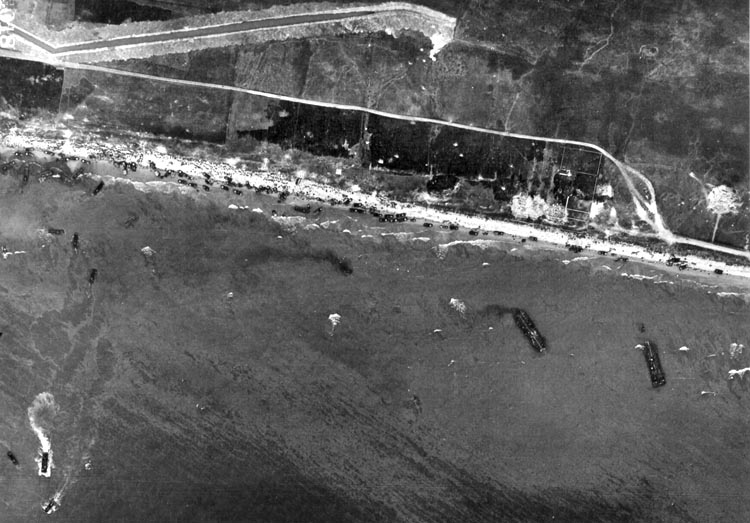
One tank roared up behind Private Robertson, who was lying in the water. He got up and ran across the beach, preferring the dangers ahead of him than the prospect of getting flattened. Once ashore, Captain Callahan realized his radio could not contact the tanks, so he jumped onto a tank and directed its fire. While pointing out targets, enemy rounds hit both his hands, feet, face, and his right hip. He struggled to the seawall where a medic dressed his wounds.
While some of Callahan’s men huddled behind the breakwaters, others ran far enough to reach the shingle. The shingle offered scant protection from mortar fire, but the Germans had yet to deploy arcing fire on the beach. As many of the men reorganized or just caught their breath, they looked up at the mansard-roofed house and realized they had landed in the wrong place. They had no idea where they were.
The Les Moulins Draw (Exit D-3) lay between Omaha Beach’s St. Laurent Draw (Exit E-1) to the east and Vierville Draw (Exit D-1) to the west. Its 200-yard gap between the bluffs near the beach was the widest, most open, and most exposed of Omaha’s draws, assuring easy fields of fire for the defending Germans. Colonel Charles Canham’s 116th Infantry Regiment—the Stonewallers—of the 29th Infantry Division assaulted the Les Moulins and Vierville draws on D-Day, while Colonel George A. Taylor’s 16th Infantry Regiment of the 1st Infantry Division assaulted St. Laurent as well as the Colleville Draw (E-3) and Cabourg Draw (F-1) farther east.
Oddly enough, it was the Les Moulins Draw, not the St. Laurent Draw, that led to the town of St. Laurent, half a mile south of the beach. Three Allied beaches faced Les Moulins: Dog White to the west, Dog Red directly in front of the draw, and Easy Green to the east.
As one of Omaha Beach’s five draws, the Americans had to capture Les Moulins if they wanted to bring tanks, artillery, and heavy equipment off the beach and onto the high ground, linking with troops advancing through the other draws.
Major Sidney Bingham’s 2nd Battalion—more than 700 men—assaulted the draw, although that was only part of its mission. Callahan’s F and Scott’s G Companies were supposed to land abreast, with Captain Taylor Feller’s A Company, 1st Battalion to their right. Callahan was supposed to land opposite the Les Moulins Draw with Captain Lawrence Madill’s E Company to his left, but the plan did not survive the journey to the beach.
According to the plan, some 20 Sherman tanks from Lt. Col. John S. Upham’s 743rd Tank Battalion were supposed to land first in Bingham’s sector. Duplex drive (DD) tanks (floating tanks) and waterproofed tanks, delivered by Landing Ship Tanks (LSTs), would land at 6:30 am at low tide. Infantry would follow, with E, F and G Companies landing on Easy Green, Dog Red, and Dog White, respectively.
Next would come three teams—Teams 7, 8, and 9—from Lt. Col. Carl Isley’s 146th Engineer Combat Battalion to clear paths through the obstacles, mark navigation hazards, and determine landing points. As they cleared the way, H Company and various headquarters units would land. More engineers would follow.
Once Bingham had secured the beach, Lt. Col. Lawrence Meeks’ 3rd Battalion—consisting of I, K, L, and M Companies—would land,. With the infantry pushing the enemy away from their defenses, more engineers would land to clear obstacles, followed by field artillery, heavy weapons, and amphibious trucks. Finally, Colonel Eugene Slappey’s 115th Infantry Regiment—some 3,000 men—would arrive at 10:00 am for the push inland.
The Germans defended the Les Moulins Draw with four Wiederstanznests (WNs)—formidable independent strongpoints. WNs 66 and 68 stood on either side of the draw, while WN 69 stood directly south of the draw, housing launching tubes for Nebelwefers—rockets the Americans called “Screaming Meemies.” WN 67 guarded the town of St. Laurent. To the left of the draw, down near the seawall, stood the mansard-roofed house. A series of trenches connected it to other defensive positions. To the right stretched the wooden breakwaters.
A row of 10-foot-high antitank Belgian Gates (also known as Element C) stood as the first line of German beach defenses. Next were mine-topped poles sticking out of the sand, designed to destroy any waterborne craft floating at high tide, followed by a series of ramp-like log structures designed to drive landing craft onto a mine on top the structure. Finally, there were hedgehogs, five-foot high iron rails welded together at angles, and tetrahedrons, triangular cement obstacles, both designed to stop vehicles. Past the obstacles stood the shingle, the shallow, six-foot-high pile of stones that ran the length of the beach. Beyond the shingle, a seawall sloped up the road, lined with coils of barbed wire, and the 150-foot-high bluffs beyond. A 600-yard-long antitank ditch stretched atop the bluffs, making the draw’s capture all the more important.
Rough seas in the English Channel had disrupted the assault’s timing. Ship and landing craft captains struggled to coordinate their efforts. An LCT sank, taking four tanks with it. When the captains realized the waves were too heavy to risk discharging their DD tanks, they landed them directly, further delaying the tanks’ arrival. The storm tides also pushed almost all the initial landing craft left of their intended destinations.
Callahan’s and Scott’s men landed too far left of their destinations, unable to support Feller’s A Company, which was subsequently wiped out at Vierville Draw. Captain Madill’s E Company LCVPs drifted almost half a mile to the left, completely isolated from Callahan’s assault. Worse, four of Scott’s six LCVPs landed between two of Callahan’s groups, while two (including Scott’s) landed to Callahan’s left, depriving most of G Company of its commander and placing the rest of the company under command of a man they did not know.
Some of Scott’s men who landed with Callahan decided to head back to where they were originally supposed to land, farther to the right, but the trip was dangerous, with men dropping as they shifted position. The men caught a break when a German bullet pierced a private’s flamethrower tank but it did not ignite. The men sought refuge between the breakwaters’ wooden walls, which protected them from enemy crossfire but deprived them of the unit cohesion they had trained so hard to maintain.
While Scott’s men executed this ragged maneuver, Callahan’s soldiers and the rest of Scott’s men advanced only as far as the shingle, knowing that if relief did not arrive soon they would be wiped out. Sergeant Francis Ryan reached the shingle and suggested his men clean their rifles. As they did, a shell exploded nearby, and a bloody chunk of flesh landed on Private Rocco Russo’s lap. He pointed to it and asked Ryan if it was part of him. Russo did not think so but was too scared to find out. Eventually, Russo calmed down enough to help Ryan search for a way off the beach, but the two soon realized that with so few men able to fight they would have to wait for more.
Some support came from the sea. U.S. Navy battleships USS Arkansas and USS Texas had been pouring shells on enemy shore batteries since before the men landed, setting the dry grass on the bluffs afire, while the destroyers USS Thompson, USS Emmons, and USS Carmick fired over the men’s heads and hit enemy bunkers, either by aiming at enemy tracer fire or by following American tank fire. The destroyers would eventually close to within 800 yards of the beach and knock out at least eight gun emplacements along the entire four-mile length of Omaha Beach.
Finally, more soldiers, tanks, and a few bulldozers arrived. One lieutenant directed his platoon over the seawall until a bullet smacked into his forehead. He continued his job, though, then sat down, put his hand to his head, and fell over dead. Once someone arrived with wirecutters, the men dashed forward individually, giving the Germans smaller targets, and cut away at the wire.
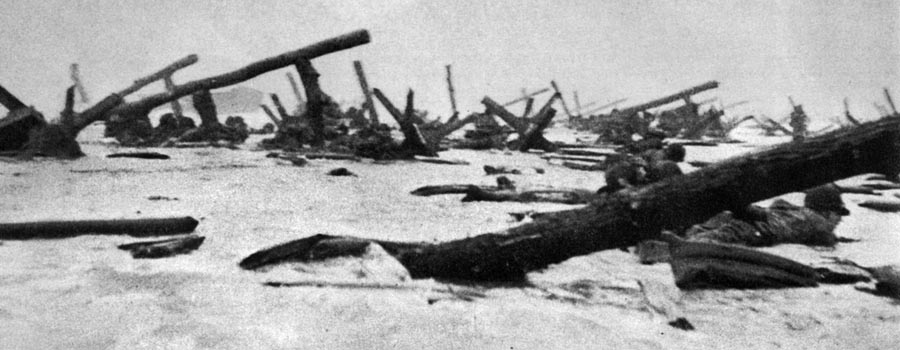
Men carrying TNT attached to wooden poles charged two pillboxes, but the Germans cut them down as they made their way through the barbed wire. The Stonewallers reorganized and charged again, this time between the pillboxes, where they found connecting trenches. They threw grenades at the Germans while jumping into the trenches and maneuvering toward the pillboxes. They then threw grenades at the pillboxes, charged in, and killed any survivors.
Engineers were next to land, but they were also off course. Teams 9, 8, and 7 landed abreast. Many engineers were cut down and unable to clear a path through the defenses. Most who made it to the beach picked up rifles and assisted the infantrymen.
Team 8’s Lieutenant Wesley Ross’s Landing Craft Mechanized (LCM) landed directly opposite the draw. The men jumped into water up to their knees and struggled to get ashore, running in short dashes and dropping. As enemy bullets splintered the tops of the beach obstacles, Ross and another soldier wrapped explosives around one while other engineers did the same. After attaching 45-second detonators to the explosives, they tossed out purple smoke grenades to warn the infantry, then moved inland. The resulting explosion destroyed some of the obstacles, but too many remained.
Team 7 landed to the right of Team 8. The engineers finished attaching explosives to their obstacles and were getting ready to detonate when a landing craft crashed into the area, setting off mines and smashing though timbers. Another craft followed. Fearing they might kill arriving Americans with their explosives, the engineers abandoned their task and helped carry the wounded away from the rising tide.
Lieutenant Colonel Robert Ploger, commander of the 121st Engineer Combat Battalion, landed a half hour after the initial assault with elements of his staff and 40 engineers. He dropped into water over his head but inflated his life belt and struggled to shore. After resting behind a German hedgehog, he charged across the beach and dropped into a shell hole, where German fire hit his left ankle.
Within an hour of the assault landing, follow-on troops approached Les Moulins. When the coxswain of one of Captain George Boyd’s H Company landing craft asked the soldiers if they recognized their draw, Boyd ordered, “Take us on in. There’s a fight there anyway.” Inside Boyd’s boat, Lieutenant Edward McNabb could see tanks on the beach. Some were firing, others were on fire. Soldiers hid behind some. “The majority of these were wounded and many dead were floating in with the tide,” recalled McNabb.
Sergeant Murphy Scott led his men off the landing craft to the left of the draw shouting, “Let’s go!” Once on the beach, his men gathered behind a knocked-out DD tank. Farther up the beach, another tank fired at enemy targets. When the tank stopped firing, Scott led his men to the seawall. They assaulted some pillboxes and trenches but found them empty. These may have been the same pillboxes Callahan’s F Company had previously captured.
As Captain Charles Cawthon, commanding the Headquarters Company, approached the shoreline in his craft, a soldier cried out, “I’m hit!” Cawthon turned to his left to see a horrible sight: “The white face, staring eyes, and open mouth of the first soldier I saw struck in battle remains with me.” He tried to offer words of comfort, but the man died without ever leaving his craft.
Cawthon exited into neck-deep water and worked his way to shore. He could not believe what he saw. “All around was incredible chaos: bodies, weapons, boxes of demolitions, flamethrowers, reels of telephone wire, and personal equipment from socks to toilet articles. Discarded life belts withered and twisted in the surf like brown sea slugs. The waves broke around the wrecked tanks, dozers and landing craft.”
While still in the water, Cawthon could see men behind the shingle and the seawall, some scooping out holes in the sand. Something exploded nearby, jarring the side of his face. As blood dripped down his chin, he rose up to run inland but found it difficult in his wet clothes and heavy equipment. He shrugged off his assault jacket and charged the shingle. Once there, he unholstered his .45 pistol only to find it encrusted with sand. When he pulled the slide back to chamber a round, it stuck halfway.
Things were not going much better for the battalion commander. Major Bingham’s boat landed to the right of the draw. His craft flipped over as he scrambled off into shoulder-deep water. What he thought were engineers blowing up obstacles in the water were actually German artillery rounds exploding on his troops. When he stopped at a tetrahedron to catch his breath, he noticed sand kicking up at his feet. Despite his exhaustion, he ran across the beach, reaching the shingle where he caught up with Callahan’s soldiers. He only saw one officer besides himself, a dazed and wounded lieutenant.
At 7:30 am, soldiers who were supposed to support Bingham arrived in the wrong place. Strong currents had pushed the four companies of Lt. Col. Lawrence Meeks’ 3rd Battalion—K, I, L, M, and Headquarters Companies—too far to the left and onto the St. Laurent Draw beaches designated for the 16th Infantry Regiment of the 1st Infantry Division. Fortunately, the men arrived where German defenses were weakest.
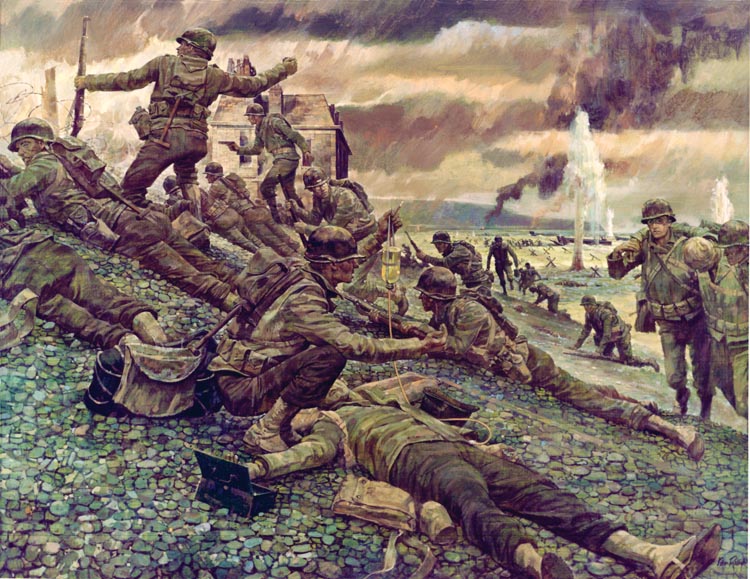
Captain William Pingey’s K Company landed closest to Les Moulins, while Captain Miflin Clowe’s I Company, Captain Charles East’s L Company, Captain Charles Kidd’s M Company, and Captain Archibald Sproul’s Headquarters Company landed closer to the St. Laurent Draw. The companies encountered mostly small-arms fire as they came ashore. Some of the landing craft got caught on a sandbar and became easy targets for the Germans. “Seasick men who’d stayed on board were blasted to smithereens,” recalled Staff Sergeant Felix Branham.
The ramps went down, and most men charged into waist-deep water. With the tide beginning to rise, they had to traverse 300 yards (100 less than the assault troops) to clear the beach. Shells rained down on the landing craft, one exploding among a group of men racing down the ramp. Men screamed as enemy fire tore into them, others ran as fast as their equipment would allow. Equipment flew everywhere. One of Captain Pingey’s soldiers, Gino Ferrari, hesitated as he made his way up the beach. Staff Sergeant Branham called to him, “Gino, move up,” as he ran past him, but a bullet caught Ferrari in the head.
When the ramp refused to drop on one landing craft, a quick-thinking sailor pulled out a pistol to shoot the ramp cable. The crowded soldiers backed away, worried that a ricochet would hit one of them. Suddenly, the ramp dropped, and the grateful soldiers charged out of the craft. A group of East’s men charged into waist-deep water and sought refuge behind the shingle. The Germans zeroed in with mortar and artillery fire, keeping the men’s heads down.
Clowe’s and East’s soldiers landed to find men from the first wave still hunkered on the beach. Meanwhile, a sergeant from Pingley’s K Company roamed the beach, urging men forward. Pingley, meanwhile, knelt on the sand smoking a pipe and staring at the defenses ahead of him.
When Lieutenant Donald Anderson discovered the men on the beach were from Scott’s company and had been on the beach for the last hour, he ordered Sergeant Joseph Dana, “Get the team on its way. We sure as hell are not staying here. This beach has too many people on it.” Dana then moved ahead and, lying on his back, began cutting through the coiled barbed wire blocking the route off the beach. Another man came over and helped until his clothes caught on the wire and enemy fire cut him apart.
When Dana finished cutting, Lieutenant Anderson led his men through the gap and up the bluff through a minefield, stopping along the way so the men could catch their breath. When enemy artillery exploded on their position, Anderson called out, “Get the hell out of here!” and the men continued up. Two of Scott’s sergeants cut the wire blocking their men and led a column through the minefield.
Captain Kidd’s M Company men had landed closest to the St. Laurent Draw. Like the previous waves, most of the men were seasick. Some ran out of motion sickness bags, while one man vomited four times before reaching the beach. When the ramp dropped on one landing craft, a squad leader in the front froze and the men shoved him out of the way as they charged out.
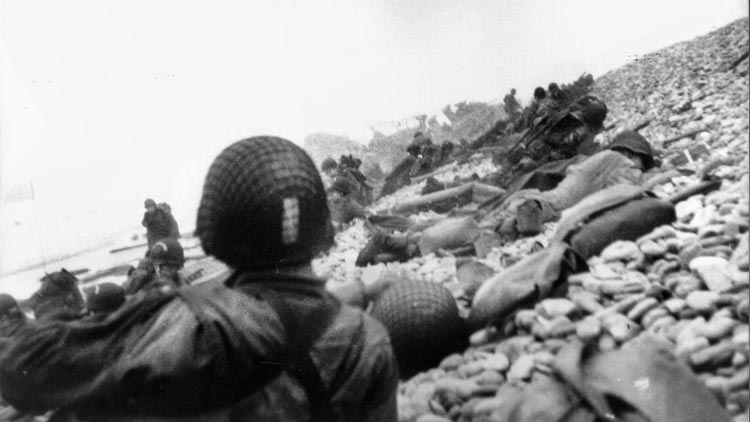
Corporal Earl Davis stepped on an underwater mine. The explosion broke his leg and shoulder while peppering his body with shrapnel. He pulled himself up the beach, away from the rising tide, and lay there until nightfall. Private Tom Lasater ran a zigzag path up the beach to prevent German snipers from zeroing in on him. “My comrades were falling around me all the way in,” he recalled. “The dead soldiers were everywhere.” Once off the beach, Lasater watched as a medic ran back into the surf to aid an injured soldier, only to be cut down by enemy fire.
Despite seasickness, injuries, and fright, the men who made it to the shingle managed to drag all their equipment with them. “The burdens that we could ordinarily carry, we had to drag,” reported Sergeant Bruce Heisley. “But we dragged it.” Some were so exhausted that they had to crawl across the beach while their NCOs shouted encouragement. Within 10 minutes, Kidd’s M Company had traversed 100 yards of shrinking beach.
Lieutenant Colonel Meeks’ craft hit a mine on an underwater obstacle as it headed ashore. The explosion tore the landing ramp off the craft, killing the men up front. A dead officer slumped onto Meeks. “I noticed he had blood oozing from his nose and mouth,” he recalled. Water poured into the craft, and the men found themselves in shoulder-deep water. They shed their equipment and waded ashore. Once on the beach, Meeks called out for the men to cross as fast as possible but to avoid bunching up.
Lying behind the shingle, Major Bingham found himself torn between feelings of futility and shock, futility that he had no control over the situation and shock at all the dead and wounded around him. The men around Bingham who could still hold a rifle were also in shock. Many had lost their weapons on their way up the beach. Captain Richard Bush felt the unarmed men “didn’t seem to see that there were weapons lying around them and that it was their duty to pick them up.”
More troops came ashore when two Landing Craft Infantry (LCIs), 90 and 94, each capable of holding 200 men, made it to the beach at 7:45. LCI 90 carried engineer and beach battalion companies, while LCI 94 carried a medical battalion and a military police platoon. After LCI 94 disgorged its troops, three enemy shells from well-camouflaged 88mm cannons exploded in the pilot house, killing three sailors and wounding two.
Clowe’s, Pingley’s, and East’s soldiers from Meeks’ 3rd Battalion ascended the bluffs to the left of Les Moulins under cover from grass fires. Captain Carroll Smith, the battalion’s operations officer, who joined the climb, felt the muzzle blast from a well-camouflaged 88mm cannon to his left. A sergeant stopped climbing and headed back to the beach to direct a tank to fire on it, but machine-gun fire cut him down before he reached the tank. Smith then crawled down the bluff to the tank, banged his rifle butt against the turret, and directed the tank crew to fire on the 88. The tank blasted away, but its 75mm cannon could not penetrate the 88’s protective concrete nest. The German crew, realizing they were under fire, switched to rapid fire, peppering anything they saw. The Americans eventually placed charges around the nest and blasted it inward.
As more and more Americans ascended the bluff, some of Captain Kidd’s M Company men set up a machine gun outside the mansard-roofed house and exchanged fire with the Germans inside. Every time someone manned the machine gun, a German sniper would get the gunner in his sights and fire. “He killed one man and wounded three or four of us,” recalled Private John Hinton.
Around 8 am, Bingham gathered 50 men from his staff and one of Callahan’s F Company platoons and led them in a charge against the house. They crossed the coiled barbed wire and pressed their bodies against the sea wall. Bingham tried to raise the Navy on his radio but failed. When he realized no one had a working weapon, he ordered the men to clean their rifles and pointed out where others could find weapons. Once the men were confident about their weapons, they charged the house.
Inside, they managed to clear the first floor, but when they made it to the second, despite a destroyed staircase, they discovered their weapons still would not fire. A frustrated Bingham ran back to the seawall where he again tried unsuccessfully to radio the Navy. He then sent 10 men around the left of the house where, using wirecutters, they penetrated more barbed wire and climbed the bluff. Bingham sent reinforcements, but the soldiers returned, complaining that their weapons would not fire.
Sergeant John Thaxton of Callahan’s F Company charged past the fortified house and into an enemy trench near the base of the bluff. He landed next to a still-warm enemy machine gun. When he stood up, he saw another American soldier with arm cocked, ready to throw a hand grenade at him. The man stopped himself.
Colonel Paul Thompson, commander of the 6th Engineer Special Brigade, joined Bingham’s assault, leading men against a German machine gun. Thompson blew another gap in the barbed wire and led the charge until enemy fire caught him in the neck and shoulder. A soldier treated his neck wound, but when Thompson pointed to his shoulder and then to the man’s first-aid pack, the soldier told him, “To hell with you, you son-of-a-bitch, I might need it later on today for myself.”
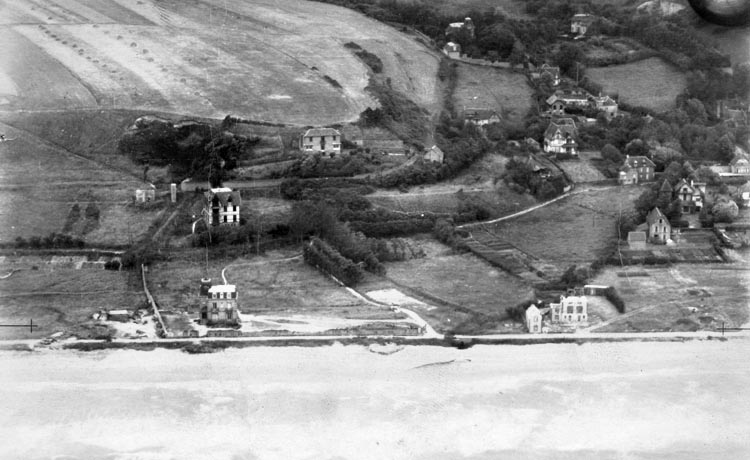
While more men assaulted the bluffs, Bingham looked for more men to send up. He came across Captain Cawthon, the Headquarters Company commander, cleaning his weapon with the other men, his face cut up from the shell that had exploded near him earlier. “This is a debacle,” Bingham told him, then ordered Cawthon to round up some firepower. Cawthon ran down to the beach looking for discarded weapons. He was shot on the opposite side of his face from his first wound, but it did not kill him.
While Bingham tried to take the house and send men up the bluff, four LCTs headed in abreast and discharged men, jeeps, and bulldozers. German artillery fire splashed around them as machine guns swept the surf. Several bulldozers rumbled off one LCT into deep water, yet managed to reach shore, only to be put out of action by phosphorous shells. A few men followed, holding their rifles over their heads, but when two men were shot heading down the ramp, the rest of the men refused to leave. Ensign Donald Irwin, the ship’s captain, tried in vain to get the men to disembark for an hour, until word came to withdraw from the beach.
As Irwin withdrew, he noticed two soldiers ashore, one with his arms wrapped around a wooden pole obstacle while the other held onto his waist. Enemy bullets splintered the wood around the men. To make matters worse, they were fighting the incoming tide, which forced them to cling higher and higher to the pole. “Sooner or later they would have no log left for protection,” Irwin wrote in his diary. “I often wonder if they survived.” Irwin returned to the beach around 2 pm, and his men went ashore. Unfortunately, all the jeeps that rolled off stalled in the deep water.
Two LCTs delivered truck-towed 57mm guns of the 116th Antitank Company, but they were practically useless on the shrinking beach, with no room to maneuver or set up. Lieutenant Forrest Ferguson made it to the shore to find men pinned down. He led three men to the coils of barbed wire and rammed Bangalore torpedoes underneath before detonating them with a hand grenade. With a gap in the wire, Ferguson stood up and shouted, “Let’s go men!” The soldiers followed him until an enemy bullet hit his head. Although it did not kill him, it took him out of the battle.
Most of the support artillery never made it to the beach. Almost every one of the DUKW amphibious trucks carrying the 105mm howitzers for Lt. Col. Thornton Mullins’ 111th Field Artillery Battalion foundered in the Channel. British patrol boats picked up some of the artillerymen. Master Sergeant John Hickman, on an LST carrying the DUKWs, watched the vehicles roll into the water and sink. “I can still hear those men calling for help over the noise.”
Around 9 am, a Rhino Ferry packed with jeeps, trucks, supplies, and men from the 111th touched shore. “The beach was a mess with wrecked equipment and dead soldiers,” remembered Private Forrest Brooks, “but the heavy shelling had slowed down quite a bit.” The surviving artillerymen stood dumbfounded until Lt. Col. Mullins called out, “To hell with our artillery mission! We’ve got to be infantrymen now!” Mullins spotted targets for a tank. Eyeing a machine-gun nest, he directed the tank until a sniper’s bullet tore into his abdomen.
LCVPs carrying mortarmen from a chemical mortar company approached the beach in a hail of enemy fire. The men climbed off their landing craft into waist-deep water, pulling carts filled with unassembled mortars. They had wrapped the carts with inflatable life belts to ensure their safety. The Germans fired on the carts, quickly deflating the belts and sinking the mortars in the surf.
By 11 am, Lt. Col. Meeks’ men reached the top of the bluff to the left of the draw and yelled back to the men following to watch out for mines. Private Lasater, from Kidd’s company, followed a trail up the bluff despite his training to the contrary. Men on either side of him triggered mines. One man was blown to the bottom of the hill. “The trails up the hills were the safest place because that was what the Germans used,” Lasater later wrote.
While Meeks’ men fought their way south, Bingham shifted his hodgepodge of soldiers to the left of the Les Moulins Draw, paralleling Meeks’ route up the bluffs and penetrating farther south before turning right to St. Laurent. His men ran up against both WN 67, defending St. Laurent, and WN 69, with its Screaming Meemie rocket battery. The Germans were firing rockets on the beach as fast as they could reload the launch tubes.
Two groups of Meeks’ men and a group of Bingham’s attacked the battery. Around noon, Captain East’s L Company, reinforced by soldiers from Captain Clowe’s I Company, pushed into an orchard where they could see the rocket battery. They set up mortars and brought the area under fire. The Germans retreated into a house. Then, Lieutenant Robert Garcia from Captain Madill’s E Company ordered a machine-gun crew to open fire on the rockets. The gunner pulled the trigger, and a stream of bullets arced toward the launchers. “We could see the Germans begin to move their guns, but not soon enough,” Garcia reported. “All of a sudden there was a terrific explosion and a big ball of flame.” The explosion may have actually been from the guns of the destroyer USS Thompson,which fired some 30 rounds at the smoke trails left by the launching rockets. The battery went dead.
Some of Captain East’s men advanced across a series of hedgerows. When they came under fire, Lieutenant Anderson looked over a hedgerow, but as he did so a German sniper shot him in the back of the head. The bullet came out Anderson’s mouth. As he lay wounded, a sergeant came over and stole his watch.
Soon, Captain Pingley’s K Company joined the other men as they pushed to the edge of the draw. They spotted Germans on the opposite bluff, but heavy enemy machine-gun fire, artillery, and snipers prevented the Americans from crossing. They stayed in that position for the rest of the day, waiting for reinforcements.
Out in the Channel, Colonel Eugene Slappey’s 115th Infantry Regiment was supposed to arrive at 10 am for the drive inland, but when the skippers of the 12 LCIs carrying Slappey’s men saw the heavy enemy fire on the beach and obstacles still intact, they turned around. They instead disgorged the men to the left of the St. Laurent Draw an hour later and a mile and a half from Les Moulins, in the 16th Infantry Regiment’s area. When Brig. Gen. Willard Wyman, the 1st Infantry Division’s assistant commander, saw the 115th arrive intact, he ordered Slappey to assault the town of St. Laurent from the west. Slappey’s fresh troops advanced some 1,000 yards inland, crossed the St. Laurent Draw to their right, and worked their way through hedgerows, fields, and a minefield, marking it with handkerchiefs and bandages as they went.
On their way to St. Laurent, Slappey’s men had a perfect view of the destruction on Easy Green Beach below. They saw dead and wounded men, destroyed tanks and other vehicles, intact enemy defenses, and landing craft and boats aflame. Enemy artillery and mortars exploded on the beach and the shore. Farther out to sea, they could see battleships and destroyers blasting away at German defenses. “At this point,” recalled Lieutenant William Ford, “I didn’t think I would ever see England again, let alone the United States.”
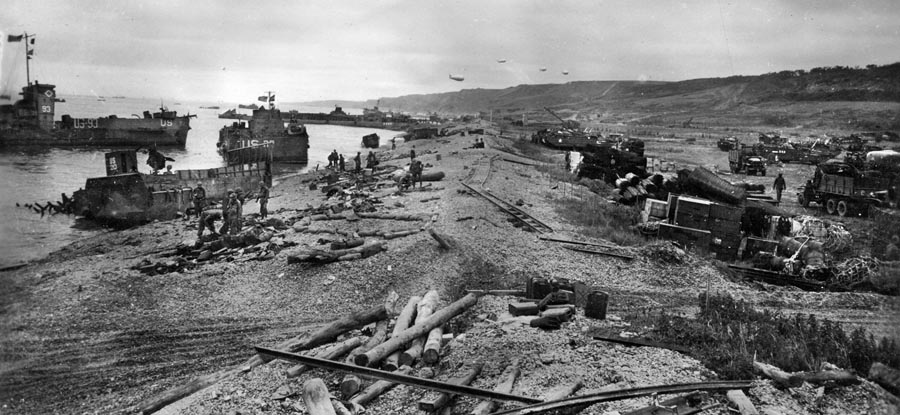
When a German sniper stymied elements of the 115th by picking off its point men, American snipers took up positions. Private Vincent Bognanni heard one of the sniper’s shots and pinpointed him in a tree with the help of his sergeant as a spotter. Bognanni got a bead on his target and fired. “You got him!” yelled the sergeant. Bognanni fired again for insurance. The German didn’t fall out of the tree. He had tied himself to it.
Slappey attacked St. Laurent with Lt. Col. William Warfield’s 2nd Battalion and Major Victor Gillespie’s 3rd Battalion. Warfield sent Captain Waldo Schmitt’s E Company and Captain Robert Kaiser’s F Company to lead the charge. Locals told two of Schmitt’s scouts that the Germans were ensconced in the town church, surrounded by a stone wall and a wrought iron fence. As the men entered the town, they came under sniper fire and soon realized that many of the German defenses were connected by tunnels, allowing the snipers to change positions. German machine gunners, also in the church steeple, fired at anything that moved.
Lieutenant Colonel Warfield, showing calm amid the bullets whizzing past him, sat nonchalantly on a curb while tossing pebbles at a lounging dog. As the fight raged, a joint assault signal officer radioed the Navy to fire on the church. The first round crashed into the steeple, collapsing it. More followed. For the rest of the day, the Americans found themselves dodging enemy fire as well as their own Navy’s.
While Warfield’s and Gillespie’s men captured the village, Slappey sent Lt. Col. Richard Blatt’s 1st Battalion south of St. Laurent, flanking it and cutting it off from German reinforcement. Blatt completed his mission around 4 pm.
Back on the beach, things had calmed down. Engineers worked to make the Les Moulins Draw suitable for vehicles and armor by disabling mines and bulldozing obstacles. A sergeant with the Engineer Special Brigade, who had lost an eye, directed the engineers. When the men utilizing a bulldozer were wounded, he treated them even though he was in worse condition than some of them.
As the sun lowered in the sky, Colonel Slappey ordered Warfield to the western end of St. Laurent, although the enemy still controlled several buildings near the road heading south. To clear out the Germans, Slappey ordered Gillespie, supported by tanks that had made it up the draw, to conduct a night assault. The men and tanks pushed through the town, clearing out machine-gun nests, but as a tank pushed down a narrow road between two stone farmhouses, a high-velocity projectile streaked by. Germans in the upper stories poured fire on the Americans, forcing a retreat.
Gillespie’s men then got some unexpected support. Eleven M-7 Priests, self-propelled artillery howitzers, from Lt. Col. Bernard McQuade’s 58th Field Artillery Battalion had made it ashore around 6:30 pm. Lt. Col. John Cooper, the 110th Field Artillery Battalion commander who had landed with Slappy’s 115th, requested some of the Priests to ferret out the Germans. The Priests roared into town and blasted their howitzers at farmhouses. “The Germans began to fly out of the windows left and right,” recalled Cooper.
The Germans were finished in St. Laurent. The collapse of enemy resistance also meant that American engineers, who had been scarce during the day, could remove more beach obstacles and enable a heavier flow of traffic through the draw.
Warfield and Blatt set up defensive positions south of St. Laurent, trapping the last German defenders of the Les Moulins Draw. Before midnight, Blatt was looking for a place to set up his mortars when an enemy mortar barrage exploded around him. A piece of shrapnel ripped into his head above his right ear. He was sent to an aid station where he insisted the medics take care of the other wounded. He died the next day on a ship crossing the Channel.
Les Moulins Draw had been a tough fight. Elements of 12 battalions had spent the day fighting across the beaches, bluffs, and hedgerows, and through the town of St. Laurent, all within a single square mile. By the time the sun rose the next day, scattered Germans continued to harass them, but it was clear the Americans now controlled the draw.
Frequent contributor Kevin M. Hymel is a historian for the U.S. Air Force Medical Service and the author of Patton’s Photographs: War As He Saw It. He is also a historian/tour guide for Stephen Ambrose Historical Tours where he leads tours of General Patton’s European battlefields and often visits Omaha Beach.
